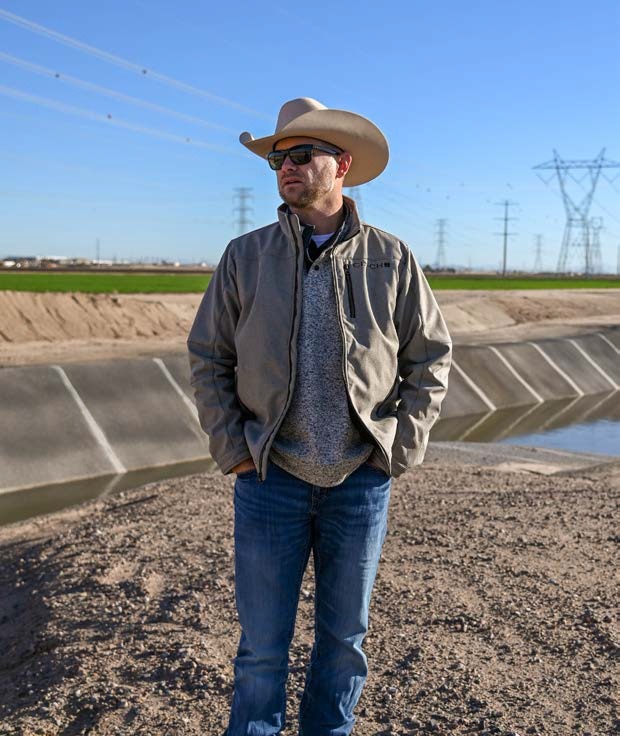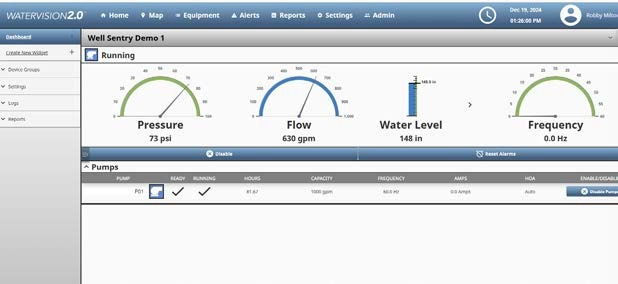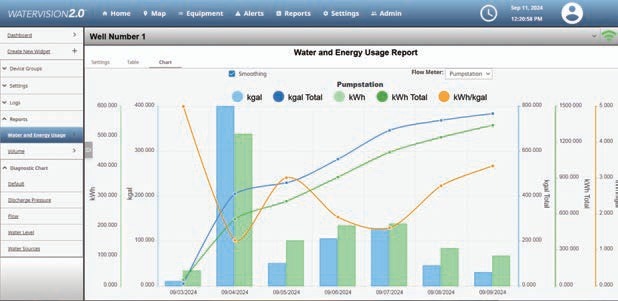Buckeye Water Conservation and Drainage District Teams Up With Watertronics to Pioneer New System Control Technology
The Well Sentry dashboard.
For more than 135 years, Buckeye Water Conservation and Drainage District (BWCDD) has provided water to the Buckeye Valley, southwest of Phoenix, Arizona. BWCDD operates the Buckeye Canal, mixing water from the Gila River with treated effluent and groundwater for delivery to irrigation customers. The district also acts to balance and control soil salinity throughout its drainage network. BWCDD is now upping its operational game by testing a new network of labor- and resource-saving software and hardware. It has teamed up with Watertronics, a company that offers custom pumping solutions for agricultural and commercial applications. Watertronics’ Well Sentry product is more than a passive well monitoring device. This smart pump technology delivers full remote control and controls individual pumps for flexible and efficient operations while minimizing unscheduled outages and costly repairs. In this interview, BWCDD’s Noel Carter and Tyler Frew and Watertronics’ Robby Milton share more information about their collaboration.
Irrigation Leader: Would each of you tell us about your background and how you came to be in your current position?
Noel Carter: I worked in heavy civil construction before joining BWCDD as the general manager in 2017. BWCDD supplies irrigation water from the Buckeye Canal, built in 1885, to agricultural and residential lands in the Buckeye Valley. The main canal is 23 miles long, and the south extension canal is 7½ miles long. We irrigate 18,000 acres of agricultural and residential land, manage local aquifers, and provide power to our customers. We have about 50 production wells between the main canal and the south extension. We operate eight drainage wells to manage the water level and the aquifer.
Tyler Frew: I am the well maintenance supervisor at BWCDD. I have been here for about 3½ years. Before coming to BWCDD, I worked at the Buckeye Irrigation District for about 14 years, doing work similar to what I do now as a maintenance manager.
Robby Milton: I have been in the irrigation pumping system business for more than 35 years. I am the technical sales, product, and market development manager at Watertronics, specializing in large-scale agricultural projects. Watertronics is a family-owned pumping system manufacturer that has been in business since 1987. Watertronics builds golf, agricultural, municipal, and industrial prepackaged pumping systems and control packages. We make pumping systems of all sizes, from small landscape stations to large irrigation district pumping systems.
Irrigation Leader: BWCDD and Watertronics jointly developed the Well Sentry. Would you tell us how this came about?
Noel Carter: Water Strategies invited me to tour Watertronics’ facility in 2022 to look at a prototype the company was developing. We discussed what features would be most helpful to irrigation districts. BWCDD gave Watertronics a lot of information to look at. Over the following year, the company implemented our ideas. It invited us back to look at the revamped system. It has been a fantastic partnership working with Watertronics to develop this system.
Noel Carter, the general manager of BWCDD.
Irrigation Leader: How long has Watertronics been developing this product?
Robby Milton: Originally, Well Sentry began as a different product. Watertronics has a product called the generalpurpose input/output kit, or GPIO kit, a device for various remote monitoring and control applications. I came upon the idea that we could make a specialized unit out of this, specifically for water districts that were operating oillubricated turbine pumps to put water into canals. That said, it will work with any type of well.
Irrigation Leader: Would you describe the Well Sentry and its benefits?
Robby Milton: The Well Sentry is a small control panel with some preprogrammed logic that operates on our WaterVision 2.0 platform. WaterVision 2.0 is Watertronics’ proprietary remote monitoring and control software. With it, you can remotely start and stop a well with your phone or computer and receive alerts if there are issues with the well.
When you start a well, it gives you a start sequence that includes a drip doser to start up the oil dripper, which drips before the well starts. As long as the oiler is functioning properly and the well does not restart too soon, it will start the well. WaterVision then displays the flow rate, pressure, the well level, and power use. If the pump has a variablefrequency drive, you can see the frequency at which the pump is running. With the power monitor feature, you can also see the actual power consumption at any given time.
You can also chart and graph the flows, pressures, levels, and kilowatt-hour usage. You can graph your kilowatthours per acre-feet, so you can see if your well is starting to lose efficiency, and even set up an alert that lets you know if efficiency starts to drop.
The Well Sentry dashboard
Noel Carter: With the click of a button, we can now see groundwater levels, pumping water levels, static water levels, power consumption by acre-foot, and charts and graphs that display power consumption. We even have integrated drip dosers with vibration sensors, so we know if something goes wrong with the well. We do not have to go out and manually start the wells and the drip systems. We can take care of it from our cell phone or tablet. Being able to see the efficiency of a well and determine whether it is starting to fail is key. To be able to shut it down is much better than to endure a catastrophic failure. We could not determine that a well was failing prior to installing Well Sentry. It still costs money to pull pumps out and repair them, but probably not as much as it would cost if we did not know something was going on.
Tyler Frew: It’s helpful to integrate the automatic drippers with the remote start and stop and to see our water levels and flows in real time. It has made our maintenance and day-to-day operations much easier.
Irrigation Leader: How much does the Well Sentry cost?
Robby Milton: The base unit costs approximately $6,000, but that does not include peripheral devices, such as flow meters, pressure transducers, vibration switches, or power monitoring. Each additional function adds to the cost. At Buckeye, with a full list of features, the per-unit cost was right at $10,000. There were some installation costs involved with that as well. As more of these units enter the market, we can bring the price down. The cost depends on how much functionality you want and what metrics you want to monitor.
Irrigation Leader: How many of these controls have been installed at Buckeye so far?
Robby Milton: We recently installed the first three. All are up and running now. I think BWCDD is happy with what the controls are doing right now. We are tweaking a few things to give them a little more functionality in the future.
Irrigation Leader: Mr. Carter and Mr. Frew, how has the Well Sentry improved your operations?
Tyler Frew: Right now, it is nice to know that we have remote capabilities to start and stop things based on our needs. As Robby’s comments about the prelubrication with the oil implied, the Well Sentry assures us that everything is working properly before anything gets started.
Noel Carter: Before installing this equipment, we couldn’t see in real time what these pumps were producing. We tested them twice a year, and every day, we would account for the water coming in based on those tests. We can measure water delivery and use directly now rather than making those assumptions. Without direct measurement, discrepancies between the actual well production and the calculated amount can add up over time. With this platform, we can see in real time what the wells are producing and how much water is coming into the canal, which helps our watermaster schedule deliveries to our customers.
Paired with a Well Sentry device, Watertronics’ WaterVision 2.0
platform can provide information on the water and energy use of a well.
Irrigation Leader: BWCDD is the first district where the Well Sentry has been installed. Do you plan to install more?
Noel Carter: We did three beta test sites to make sure it was doing what we had anticipated. So far, it has done exactly as Watertronics told us that it would do. We need to work toward automating all our wells, and Well Sentry is the platform that we are happy with. We tried other platforms, and they were not the best in terms of their functionality or even their operation. I intend to move forward with Watertronics and get all our wells completely equipped with the WaterVision platform.
Irrigation Leader: What has working with Watertronics been like?
Noel Carter: I would point to Watertronics’ commitment and vision to provide the best-quality product at an affordable price. Its commitment to provide technical support on all its products greatly impressed me when I visited its facility. Watertronics has every one of its products up and running in a room where technical support can go in and simulate problems, error codes, or other issues in order to walk you through how to fix the problem. The company’s commitment to customer service is far better than anything else I have ever seen. I want to make sure that people know that Watertronics does what it says. I am very happy with the company.
Irrigation Leader: Is there anything you would like to add?
Robby Milton: Outside of being great equipment, Well Sentry is also a money-saving product. Its vibration sensing capabilities and its ability to tell the user when a well is starting to fail or when efficiency is decreasing allows the user to switch to alternate sources in a timely manner, meaning it can really save money, not to mention labor. A district may have 50 wells. Well Sentry can let managers know instantaneously if there is a problem with one of them so that they can shut it down. They can restart the well or turn on different wells without having to travel to the well itself. That saves time and labor.




